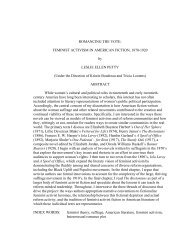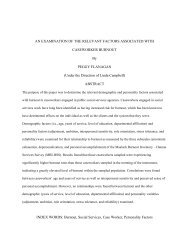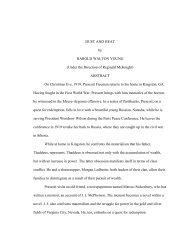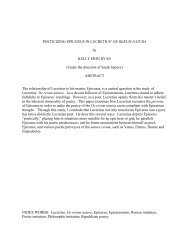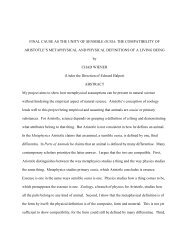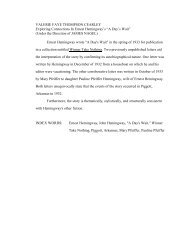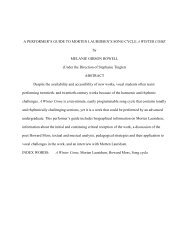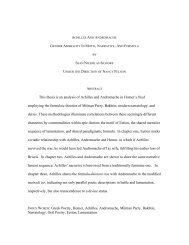exploring a popular culture body modification - Athenaeum Home ...
exploring a popular culture body modification - Athenaeum Home ...
exploring a popular culture body modification - Athenaeum Home ...
You also want an ePaper? Increase the reach of your titles
YUMPU automatically turns print PDFs into web optimized ePapers that Google loves.
Eubank, 2005). The <strong>popular</strong>ity of this shorts/skirt construction prevailed with American women<br />
into the late 1950s when bikini bottoms started to take on more of an underwear silhouette. As<br />
the upper thigh area became more exposed, women were forced to take notice of their <strong>body</strong> hair<br />
and had to make the decision of either leaving the hair to public view or depilating it. By the end<br />
of the decade Rudi Gernreich was designing risqué bathing suits and America had finally<br />
adopted Jacques Heim‟s much smaller two-piece known as the bikini. This shift in <strong>popular</strong>ity<br />
for a smaller bathing-suit silhouette further increased the possibility of exposed pubic hair.<br />
Glamour magazine‟s December 1975 issue declared “exposed <strong>body</strong> hair” the “most neglected<br />
problem of bikini wearers,” pushing women to depilate the “upper inner thigh” region even<br />
further. Also in 1975, Gernreich introduced the thong, a silhouette that completely exposed the<br />
buttocks. Wearers of this style not only have to think about pubic hair exposure in the front of<br />
the bottom, but are forced to consider any anal hair that might be exposed in the back. The<br />
1980s embraced a new bathing silhouette, the “high- thigh cut,” which looks similar to an<br />
inverted V and exposes the hip area all the way to the waistline (Tortora & Eubank, 2005). Once<br />
again, as the sides of bathing suit bottoms narrowed, unexposed pubic hair also had to narrow<br />
(Morris, 2004). Inspired by this new and very different silhouette, designers created several<br />
other bathing suit types in the late 1980s and early 1990s, including the slingshot and g-string<br />
bikinis. Considered a very controversial bathing suit at the time was Gernreich‟s “pubikini,”<br />
which came out in 1985 (Pubikini, n.d.). The fabric of the pubikini was purposefully see-<br />
through so that wearers could show off their pubic hair.<br />
The silhouette of bathing suits and negligee changed, and with new technologies so did<br />
the fabric. Into the 1960s, it was typical for a bathing suit to be cotton and most often lined. The<br />
synthetic or artificial fibers, which began to appear in the 1960s, generally had properties that<br />
17







